belt SUZUKI IGNIS 2017 Owners Manual
[x] Cancel search | Manufacturer: SUZUKI, Model Year: 2017, Model line: IGNIS, Model: SUZUKI IGNIS 2017Pages: 505, PDF Size: 8.36 MB
Page 8 of 505
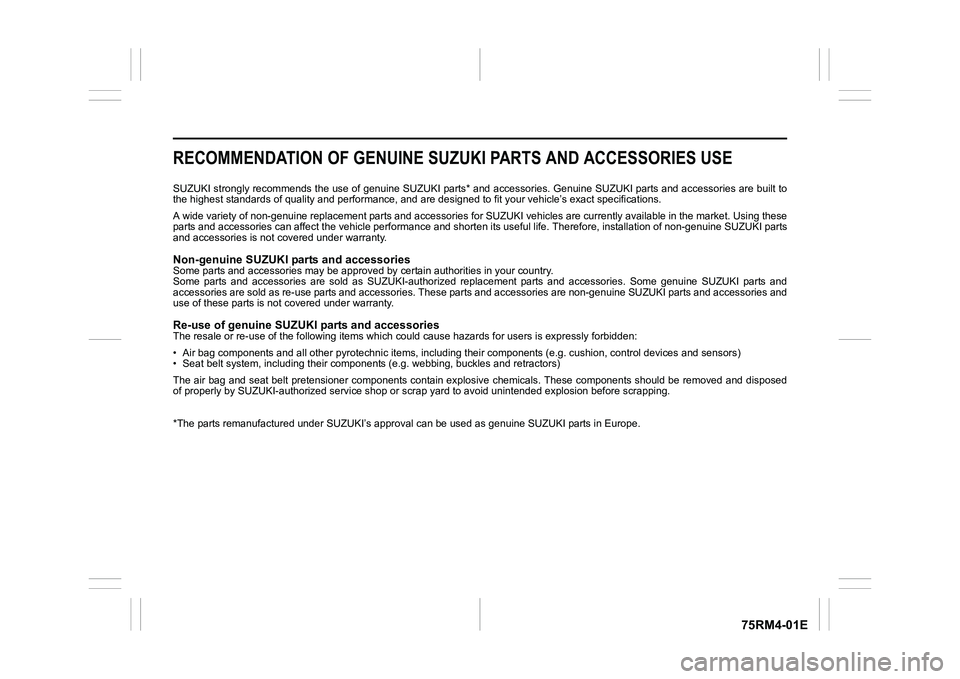
75RM4-01E
RECOMMENDATION OF GENUINE SUZUKI PARTS AND ACCESSORIES USESUZUKI strongly recommends the use of genuine SUZUKI parts* and accessories. Genuine SUZUKI parts and accessories are built to
the highest standards of quality and performance, and are desig ned to fit your vehicle’s exact specifications.
A wide variety of non-genuine replacement parts and accessories for SUZUKI vehicles are currently available in the market. Using these
parts and accessories can affect the vehicle performance and sh orten its useful life. Therefore, installation of non-genuine SUZUKI parts
and accessories is not covered under warranty.Non-genuine SUZUKI parts and accessoriesSome parts and accessories may be approved by certain authorities in your country.
Some parts and accessories are sold as SUZUKI-authorized replac ement parts and accessories. Some genuine SUZUKI parts and
accessories are sold as re-use parts and accessories. These par ts and accessories are non-genuine SUZUKI parts and accessories and
use of these parts is not covered under warranty.Re-use of genuine SUZUKI parts and accessoriesThe resale or re-use of the following items which could cause h azards for users is expressly forbidden:
• Air bag components and all other pyrotechn ic items, including their components (e.g. cushion , control devices and sensors)
• Seat belt system, inclu ding their components (e.g. webbing, buckles and retractors)
The air bag and seat belt pretensioner components contain explo sive chemicals. These components should be removed and disposed
of properly by SUZUKI-authorized service shop or scrap yard to avoid unintended explosion before scrapping.
*The parts remanufactured under SUZUKI’s approval can be used a s genuine SUZUKI parts in Europe.
Page 18 of 505
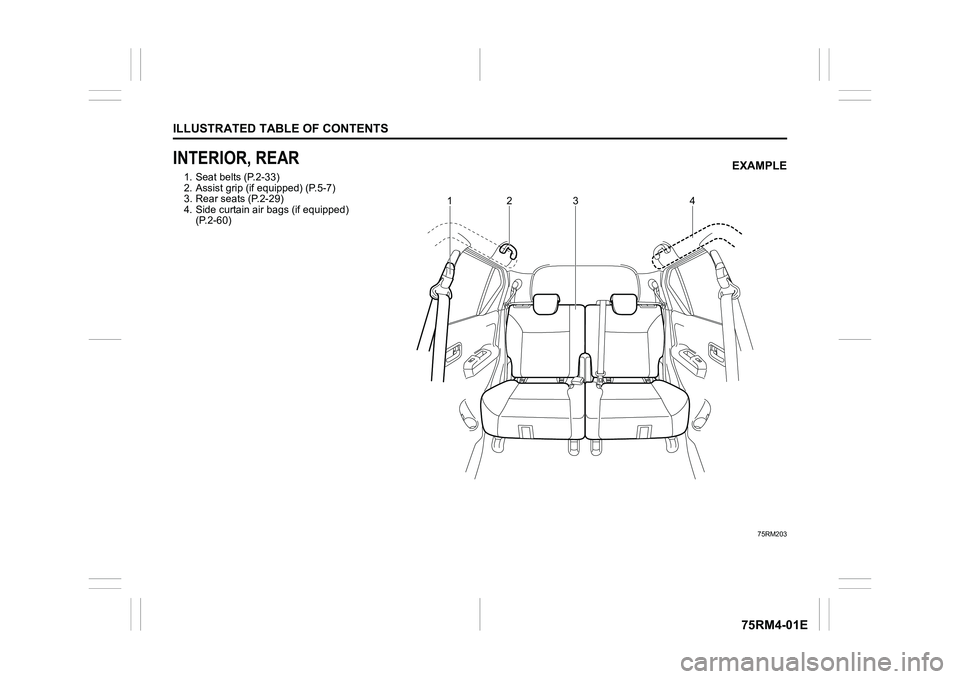
ILLUSTRATED TABLE OF CONTENTS
75RM4-01E
INTERIOR, REAR1. Seat belts (P.2-33)
2. Assist grip (if equipped) (P.5-7)
3. Rear seats (P.2-29)
4. Side curtain air bags (if equipped) (P.2-60)
75RM203
12
34
EXAMPLE
Page 23 of 505
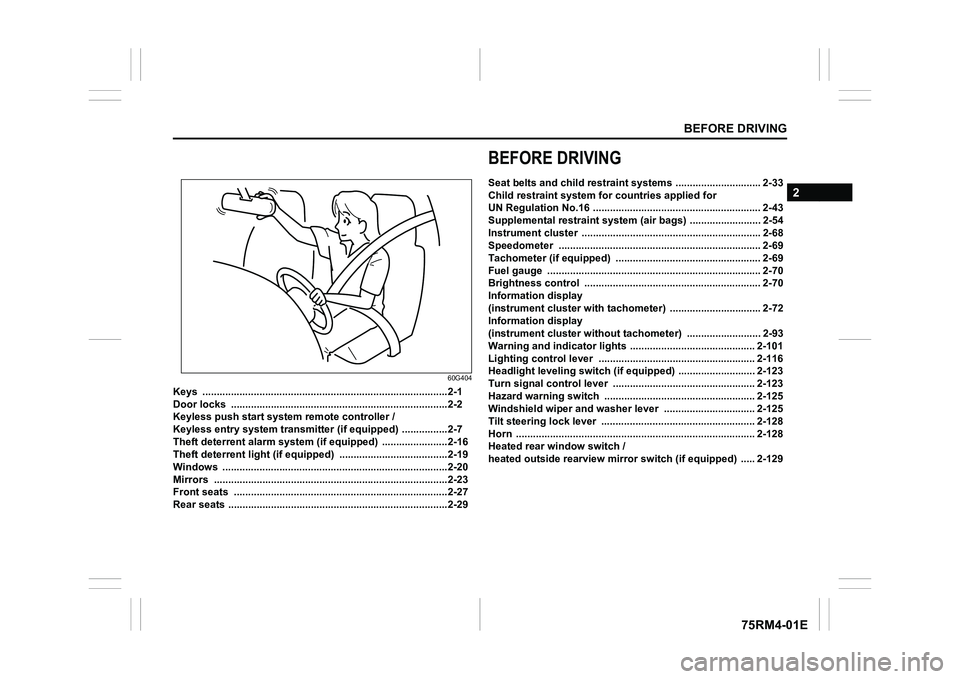
BEFORE DRIVING
2
75RM4-01E
60G404
Keys ......................................................................................2-1
Door locks .................................................... ........................2-2
Keyless push start system remote controller /
Keyless entry system transmitte r (if equipped) ................2-7
Theft deterrent alarm system (if equipped) .................... ...2-16
Theft deterrent light (if equipped) ........................... ...........2-19
Windows ....................................................... ........................2-20
Mirrors ....................................................... ...........................2-23
Front seats ................................................... ........................2-27
Rear seats .................................................... .........................2-29
BEFORE DRIVINGSeat belts and child restraint systems ........................ ...... 2-33
Child restraint system f or countries applied for
UN Regulation No.16 ........................................... ................ 2-43
Supplemental restraint system (air bags) ...................... ... 2-54
Instrument cluster ............................................ ................... 2-68
Speedometer ................................................... .................... 2-69
Tachometer (if equipped) ...................................... ............. 2-69
Fuel gauge .................................................... ....................... 2-70
Brightness control ............................................ .................. 2-70
Information display
(instrument clus ter with tachometer) .......................... ...... 2-72
Information display
(instrument clus ter without tachometer) ....................... ... 2-93
Warning and indicator lights .................................. .......... 2-101
Lighting control lever ........................................ ............... 2-116
Headlight leveling switch (if equipped) ....................... .... 2-123
Turn signal control lever ..................................... ............. 2-123
Hazard warning switch ......................................... ............ 2-125
Windshield wiper and washer lever ............................. ... 2-125
Tilt steering lock lever ... ................................................... 2-128
Horn .......................................................... .......................... 2-128
Heated rear window switch /
heated outside rearview mirror switch (if equipped) ..... 2-129
Page 50 of 505
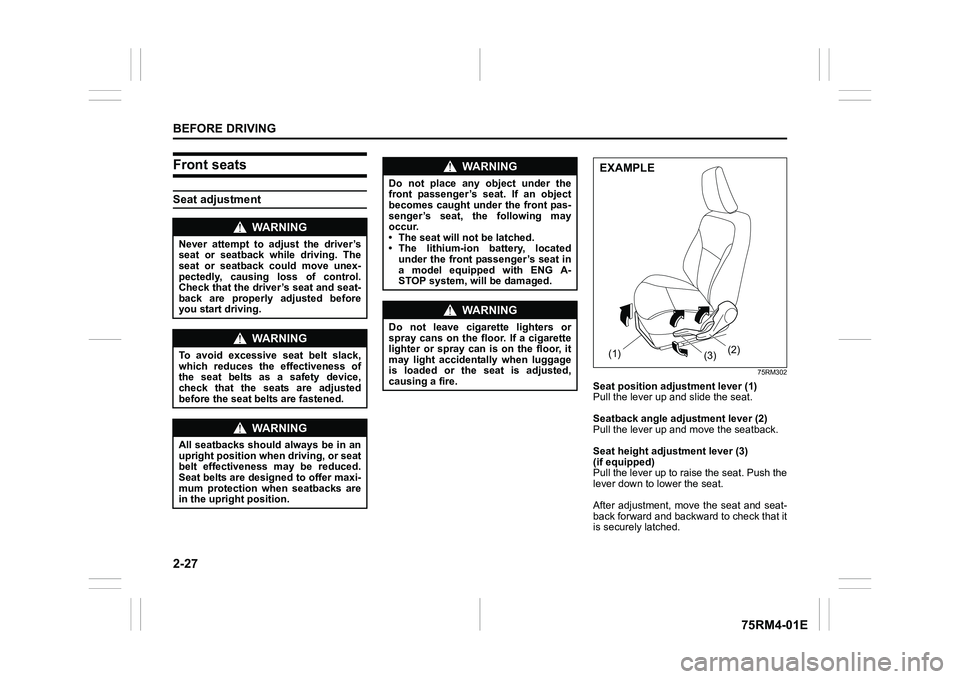
2-27BEFORE DRIVING
75RM4-01E
Front seatsSeat adjustment
75RM302
Seat position adjustment lever (1)
Pull the lever up and slide the seat.
Seatback angle adju stment lever (2)
Pull the lever up and move the seatback.
Seat height adjustment lever (3)
(if equipped)
Pull the lever up to raise the seat. Push the
lever down to lower the seat.
After adjustment, move the seat and seat-
back forward and backward to check that it
is securely latched.
WA R N I N G
Never attempt to adjust the driver’s
seat or seatback while driving. The
seat or seatback could move unex-
pectedly, causing loss of control.
Check that the driver’s seat and seat-
back are properly adjusted before
you start driving.
WA R N I N G
To avoid excessive seat belt slack,
which reduces the effectiveness of
the seat belts as a safety device,
check that the seats are adjusted
before the seat belts are fastened.
WA R N I N G
All seatbacks should always be in an
upright position when driving, or seat
belt effectiveness may be reduced.
Seat belts are designed to offer maxi-
mum protection when seatbacks are
in the upright position.
WA R N I N G
Do not place any object under the
front passenger’s seat. If an object
becomes caught under the front pas-
senger’s seat, the following may
occur.
• The seat will not be latched.
• The lithium-ion battery, located under the front passenger’s seat in
a model equipped with ENG A-
STOP system, will be damaged.
WA R N I N G
Do not leave cigarette lighters or
spray cans on the floor. If a cigarette
lighter or spray can is on the floor, it
may light accidentally when luggage
is loaded or the seat is adjusted,
causing a fire.
(1) (2)
(3)EXAMPLE
Page 52 of 505
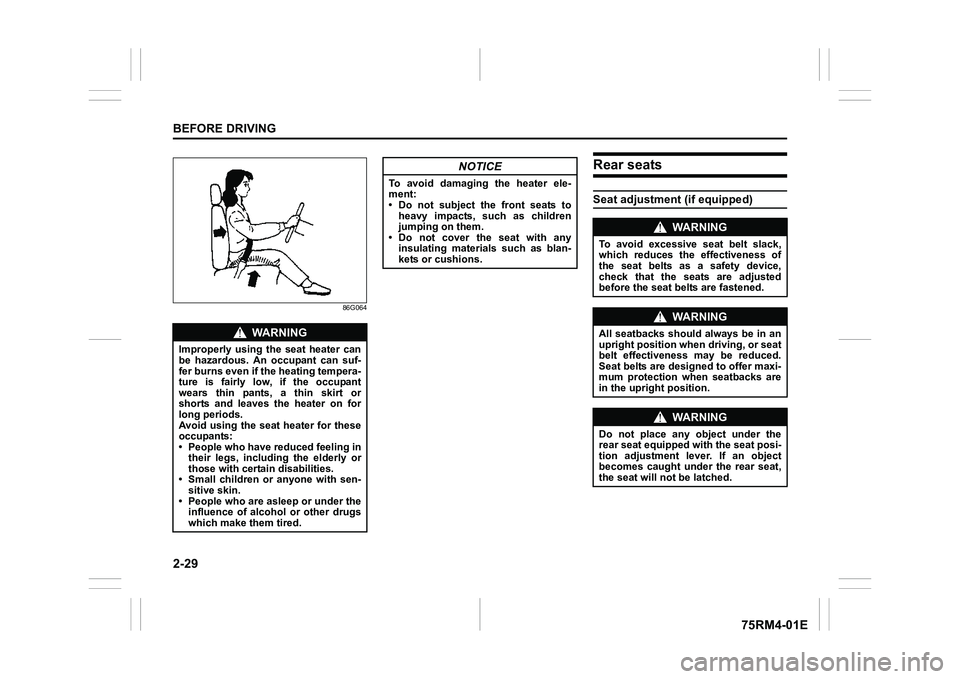
2-29BEFORE DRIVING
75RM4-01E
86G064
Rear seatsSeat adjustment (if equipped)
WA R N I N G
Improperly using the seat heater can
be hazardous. An occupant can suf-
fer burns even if the heating tempera-
ture is fairly low, if the occupant
wears thin pants, a thin skirt or
shorts and leaves the heater on for
long periods.
Avoid using the seat heater for these
occupants:
• People who have reduced feeling intheir legs, including the elderly or
those with certain disabilities.
• Small children or anyone with sen-
sitive skin.
• People who are asleep or under the influence of alcohol or other drugs
which make them tired.
NOTICE
To avoid damaging the heater ele-
ment:
• Do not subject the front seats toheavy impacts, such as children
jumping on them.
• Do not cover the seat with any insulating materials such as blan-
kets or cushions.
WA R N I N G
To avoid excessive seat belt slack,
which reduces the effectiveness of
the seat belts as a safety device,
check that the seats are adjusted
before the seat belts are fastened.
WA R N I N G
All seatbacks should always be in an
upright position when driving, or seat
belt effectiveness may be reduced.
Seat belts are designed to offer maxi-
mum protection when seatbacks are
in the upright position.
WA R N I N G
Do not place any object under the
rear seat equipped with the seat posi-
tion adjustment lever. If an object
becomes caught under the rear seat,
the seat will not be latched.
Page 54 of 505
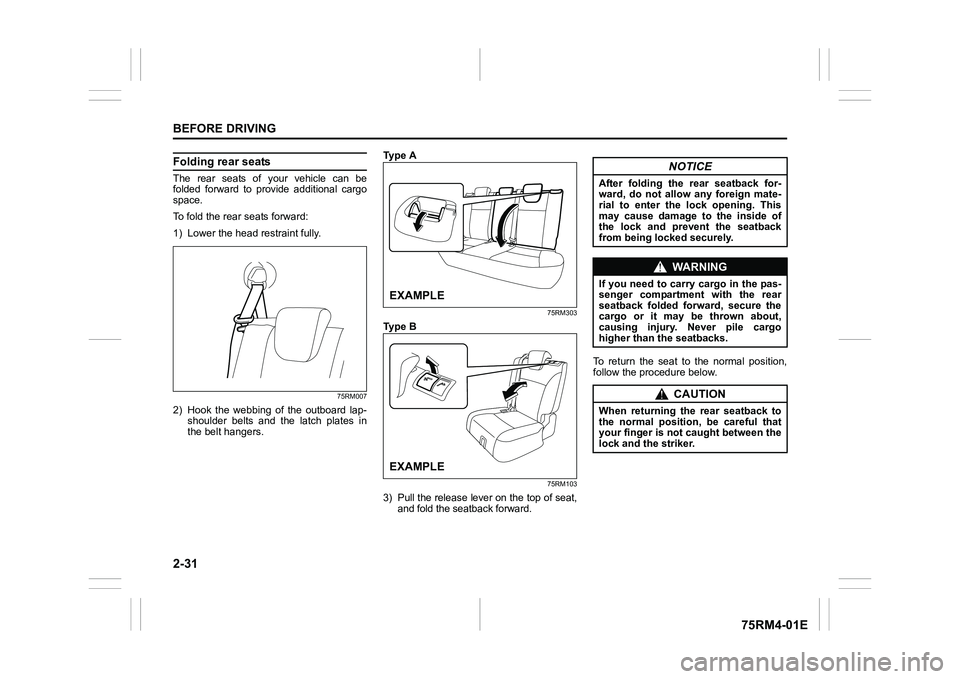
2-31BEFORE DRIVING
75RM4-01E
Folding rear seatsThe rear seats of your vehicle can be
folded forward to provide additional cargo
space.
To fold the rear seats forward:
1) Lower the head restraint fully.
75RM007
2) Hook the webbing of the outboard lap-shoulder belts and the latch plates in
the belt hangers. Ty p e A
75RM303
Ty p e B
75RM103
3) Pull the release lever on the top of seat,
and fold the seatback forward. To return the seat to the normal position,
follow the procedure below.EXAMPLEEXAMPLE
NOTICE
After folding the
rear seatback for-
ward, do not allow any foreign mate-
rial to enter the lock opening. This
may cause damage to the inside of
the lock and prevent the seatback
from being locked securely.
WA R N I N G
If you need to carry cargo in the pas-
senger compartment with the rear
seatback folded forward, secure the
cargo or it may be thrown about,
causing injury. Never pile cargo
higher than the seatbacks.
CAUTION
When returning the rear seatback to
the normal position, be careful that
your finger is not caught between the
lock and the striker.
Page 55 of 505
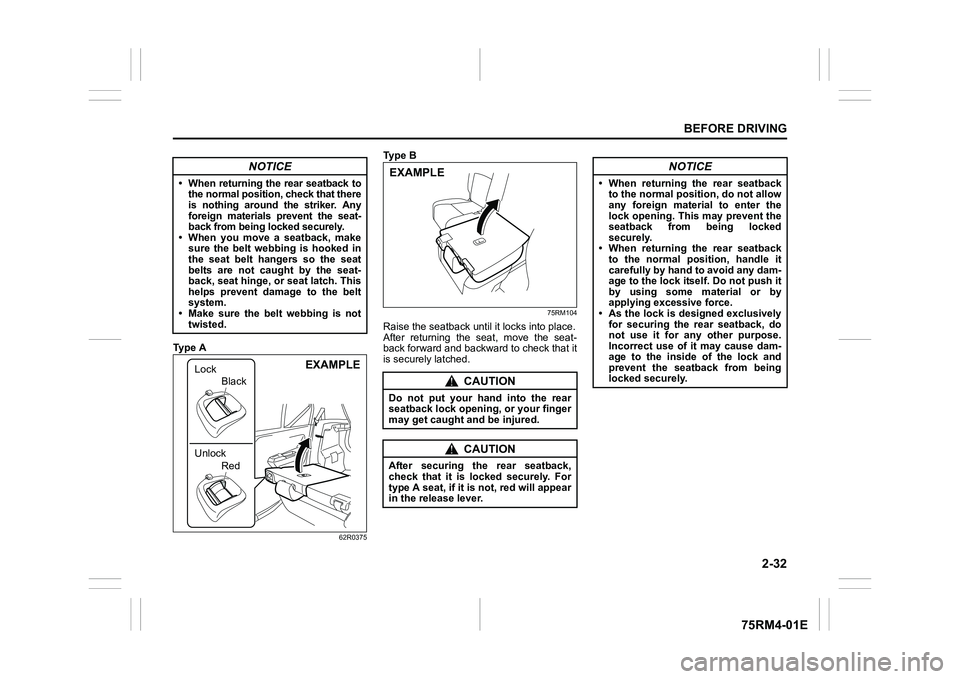
2-32
BEFORE DRIVING
75RM4-01E
Ty p e A
62R0375
Ty p e B
75RM104
Raise the seatback until it locks into place.
After returning the seat, move the seat-
back forward and backward to check that it
is securely latched.
NOTICE
• When returning the rear seatback to the normal position, check that there
is nothing around the striker. Any
foreign materials prevent the seat-
back from being locked securely.
• When you move a seatback, make sure the belt webbing is hooked in
the seat belt hangers so the seat
belts are not caught by the seat-
back, seat hinge, or seat latch. This
helps prevent damage to the belt
system.
• Make sure the belt webbing is not
twisted.
EXAMPLE
Lock
Unlock
Red
Black
CAUTION
Do not put your hand into the rear
seatback lock opening, or your finger
may get caught and be injured.
CAUTION
After securing the rear seatback,
check that it is locked securely. For
type A seat, if it is not, red will appear
in the release lever.EXAMPLE
NOTICE
• When returning the rear seatback
to the normal position, do not allow
any foreign materi al to enter the
lock opening. This may prevent the
seatback from being locked
securely.
• When returning the rear seatback to the normal position, handle it
carefully by hand to avoid any dam-
age to the lock itself. Do not push it
by using some material or by
applying excessive force.
• As the lock is designed exclusively
for securing the rear seatback, do
not use it for any other purpose.
Incorrect use of it may cause dam-
age to the inside of the lock and
prevent the seatback from being
locked securely.
Page 56 of 505
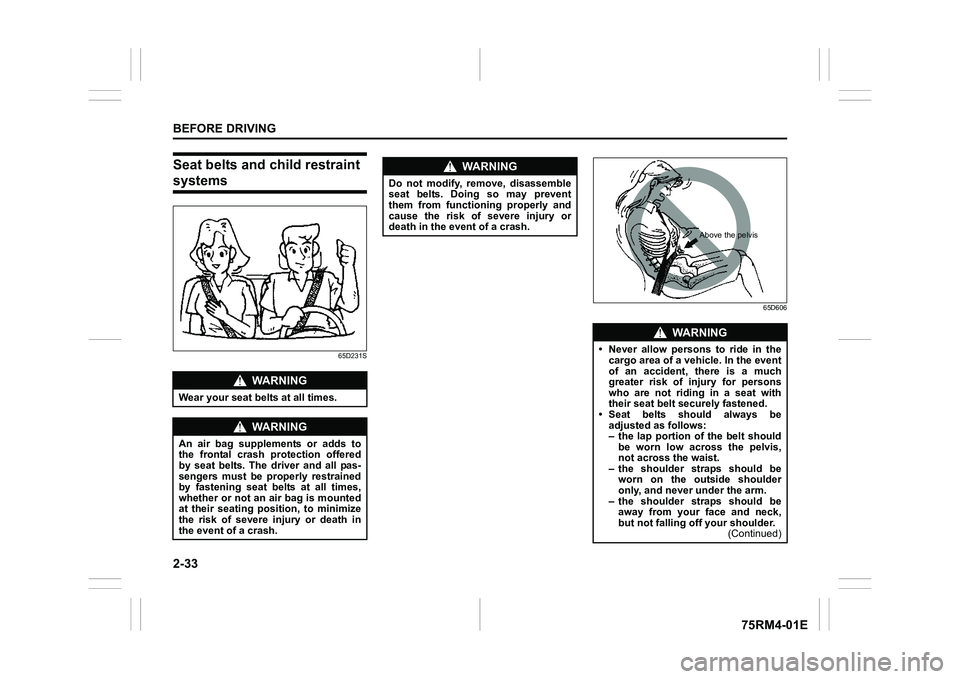
2-33BEFORE DRIVING
75RM4-01E
Seat belts and child restraint systems
65D231S65D606
WA R N I N G
Wear your seat belts at all times.
WA R N I N G
An air bag supplements or adds to
the frontal crash protection offered
by seat belts. The driver and all pas-
sengers must be properly restrained
by fastening seat belts at all times,
whether or not an air bag is mounted
at their seating position, to minimize
the risk of severe injury or death in
the event of a crash.
WA R N I N G
Do not modify, remove, disassemble
seat belts. Doing so may prevent
them from functioning properly and
cause the risk of severe injury or
death in the event of a crash.
WA R N I N G
• Never allow persons to ride in the
cargo area of a vehicle. In the event
of an accident, there is a much
greater risk of injury for persons
who are not riding in a seat with
their seat belt sec urely fastened.
• Seat belts should always be
adjusted as follows:
– the lap portion of the belt shouldbe worn low across the pelvis,
not across the waist.
– the shoulder straps should be worn on the outside shoulder
only, and never under the arm.
– the shoulder straps should be away from your face and neck,
but not falling off your shoulder. (Continued)
Above the pelvis
Page 57 of 505
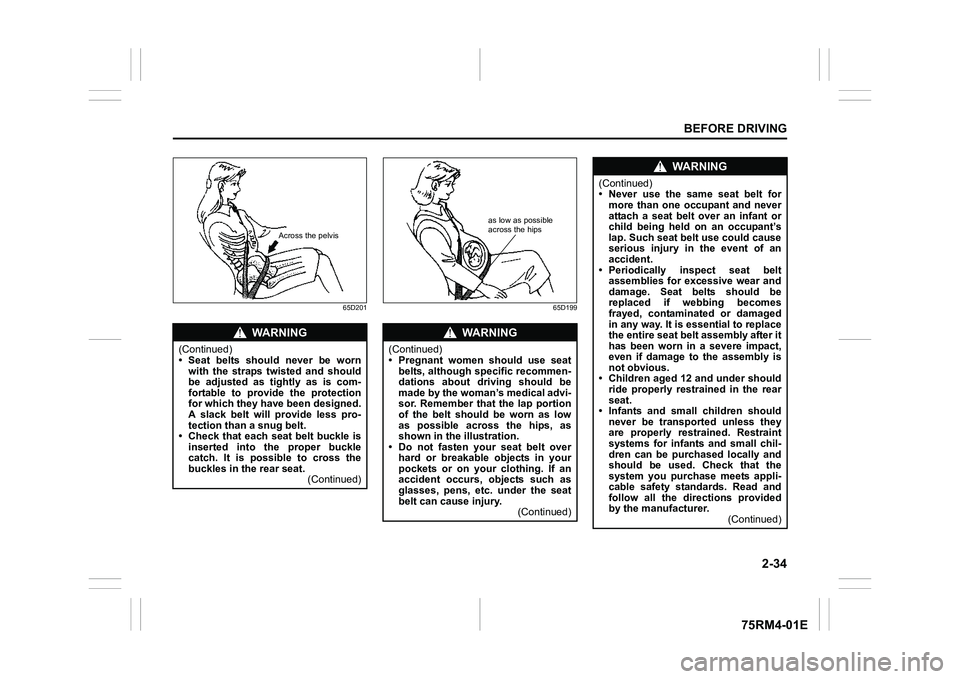
2-34
BEFORE DRIVING
75RM4-01E
65D201 65D199
WA R N I N G
(Continued)
• Seat belts should never be wornwith the straps twisted and should
be adjusted as tightly as is com-
fortable to provide the protection
for which they have been designed.
A slack belt will provide less pro-
tection than a snug belt.
• Check that each seat belt buckle is inserted into the proper buckle
catch. It is possible to cross the
buckles in the rear seat. (Continued)
Across the pelvis
WA R N I N G
(Continued)
• Pregnant women should use seatbelts, although specific recommen-
dations about driving should be
made by the woman’s medical advi-
sor. Remember that the lap portion
of the belt should be worn as low
as possible across the hips, as
shown in the illustration.
• Do not fasten your seat belt over
hard or breakable objects in your
pockets or on your clothing. If an
accident occurs, objects such as
glasses, pens, etc. under the seat
belt can cause injury. (Continued)
as low as possible
across the hips
WA R N I N G
(Continued)
• Never use the same seat belt for
more than one occupant and never
attach a seat belt over an infant or
child being held on an occupant’s
lap. Such seat belt use could cause
serious injury in the event of an
accident.
• Periodically inspect seat belt assemblies for excessive wear and
damage. Seat belts should be
replaced if webbing becomes
frayed, contaminated or damaged
in any way. It is essential to replace
the entire seat belt assembly after it
has been worn in a severe impact,
even if damage to the assembly is
not obvious.
• Children aged 12 and under should
ride properly restrained in the rear
seat.
• Infants and small children should
never be transported unless they
are properly restrained. Restraint
systems for infants and small chil-
dren can be purchased locally and
should be used. Check that the
system you purchase meets appli-
cable safety standards. Read and
follow all the directions provided
by the manufacturer. (Continued)
Page 58 of 505
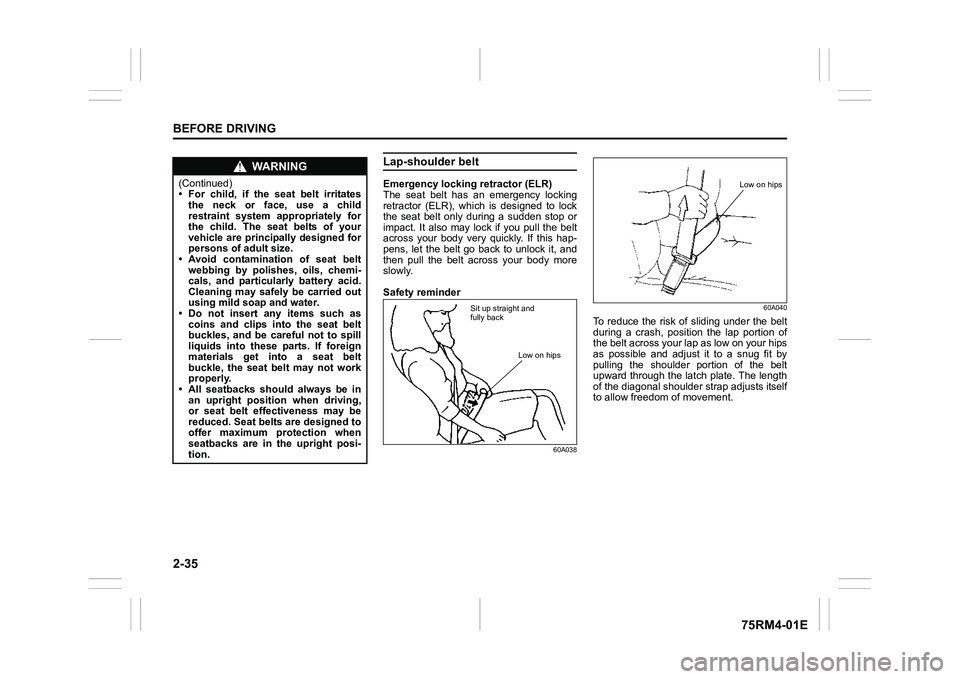
2-35BEFORE DRIVING
75RM4-01E
Lap-shoulder beltEmergency locking retractor (ELR)
The seat belt has an emergency locking
retractor (ELR), which is designed to lock
the seat belt only during a sudden stop or
impact. It also may lock if you pull the belt
across your body very quickly. If this hap-
pens, let the belt go back to unlock it, and
then pull the belt across your body more
slowly.
Safety reminder
60A03860A040
To reduce the risk of sliding under the belt
during a crash, position the lap portion of
the belt across your lap as low on your hips
as possible and adjust it to a snug fit by
pulling the shoulder portion of the belt
upward through the latch plate. The length
of the diagonal shoulder s
trap adjusts itself
to allow freedom of movement.
WA R N I N G
(Continued)
• For child, if the seat belt irritates
the neck or face, use a child
restraint system appropriately for
the child. The seat belts of your
vehicle are principally designed for
persons of adult size.
• Avoid contamination of seat belt
webbing by polishes, oils, chemi-
cals, and particularly battery acid.
Cleaning may safely be carried out
using mild soap and water.
• Do not insert any items such as
coins and clips into the seat belt
buckles, and be careful not to spill
liquids into these parts. If foreign
materials get into a seat belt
buckle, the seat belt may not work
properly.
• All seatbacks should always be in an upright position when driving,
or seat belt effectiveness may be
reduced. Seat belts are designed to
offer maximum protection when
seatbacks are in the upright posi-
tion.
Sit up straight and
fully back
Low on hips
Low on hips